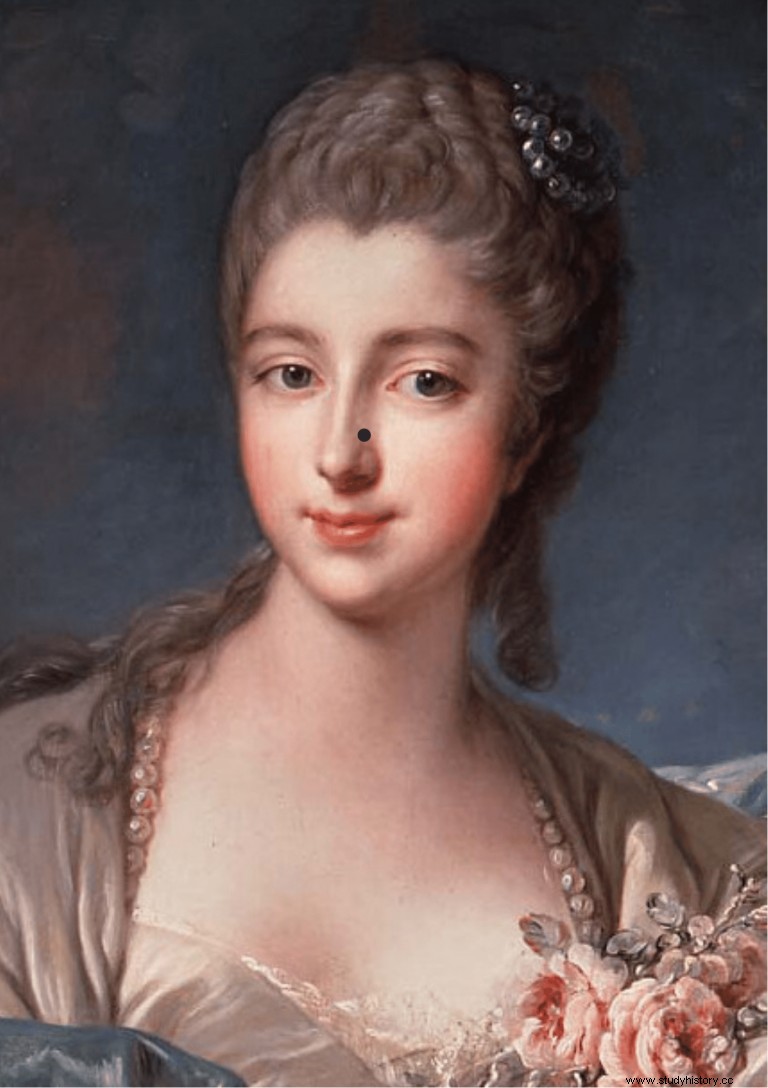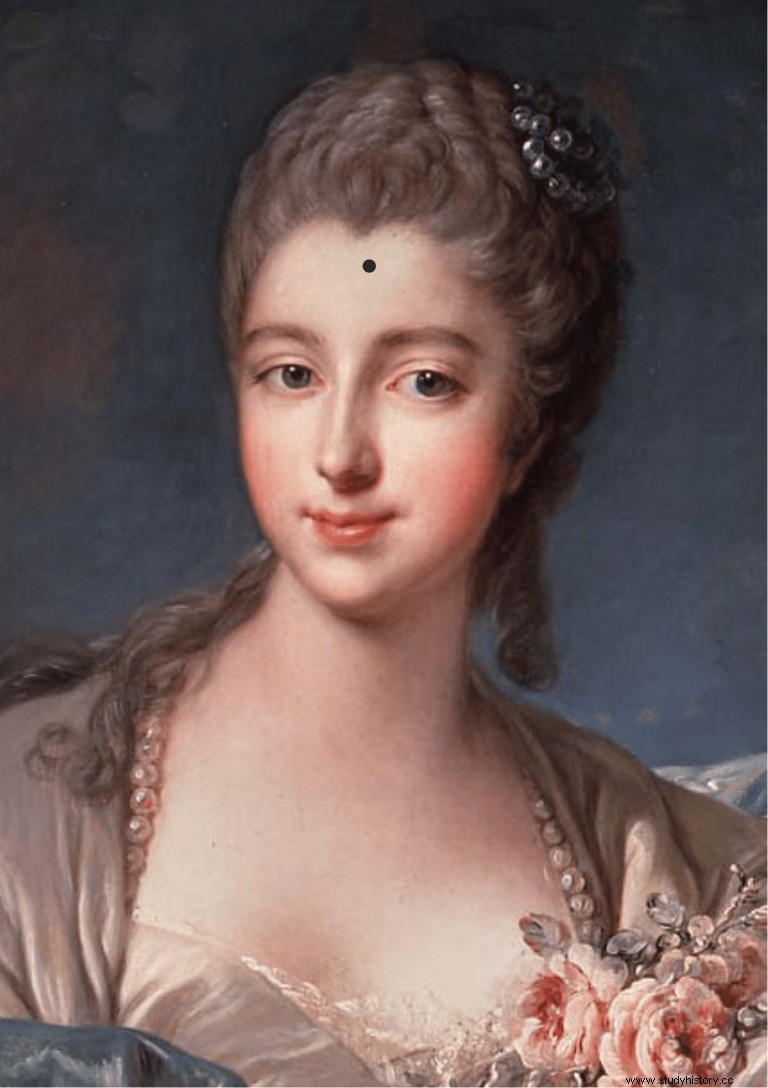Are you a discreet person? Cheeky? Passionate? No need to tell us, the Fly will speak for you! You have probably already wondered what this stain on the faces of the women in the paintings means. What was it for? What is its origin ? What does it mean ? This article answers all your questions, and tells you the history of the fly through the ages and their meaning.
THE LANGUAGE AND SYMBOLIC OF FLIES ACCORDING TO THEIR POSITION:nose, mouth, face, chest
You must have noticed that the Fly was not always placed in the same place. Sometimes on the neckline, sometimes on the cheek, on the forehead, on the chin. Depending on its position on the face or the neckline, the fly took on a very specific meaning and symbolism, to convey a specific message. It reflected the personality and mood of the person wearing it. A fly is worth more than a few words. Discover their meaning and symbolism according to the different parts of the body:



On the forehead:the Duchess or the Majestic
Close to the eye:the passionate one
On the nose:the cheeky
On the cheekbones:the playful
In the middle of the cheek:the gallant
At the corner of the mouth:the fucker
On the lips:the coquette
Under the lip, even the chin:discreet
On the chest:the generous



If you are looking for a passionate story, put your fly close to the eye. On the contrary, do you want a tumultuous adventure for one night? Place your Fly at the corner of your mouth. La Mouche leaves no room for doubt or shyness, everything you have to say will go through her.









©Flicker
THE STORY OF THE FLY
We cannot talk about the fashion for flies without talking about the history of moles. Adulated, criticized, loved, despised, valued, moles have guided the destiny of many people, especially women. This small task, which could however seem so insignificant, was not seen in the same way by everyone.
The mole in the world
In Ancient Greece, where symmetry and harmony in everything is key, moles were frowned upon. It is said that among the Persian and Arab peoples, they were seen as a sign of beauty, they would be the first to have carried the fly.
The Middle Ages:the devilish mole
In medieval France, women with moles met a tragic end. The Church considered these tasks to be the entry point of the devil into the body:they were therefore equated with witchcraft. The poor women who wore what would be worshiped three centuries later were hunted down by the King's guards and the villagers, in order to be tortured and burned alive in the village square as witches.
In order not to end up at the stake, the most courageous applied a stone or a heated iron to their face to make these moles disappear.

The Modern Age:birth of the fly
It is then in the 17th century that it will be talked about, more positively. When smallpox is rampant, the fly will be used to hide the ravages of this infection. It will also be used to hide pimples, which are very common at this time.
The Contemporary Age:the Fly becomes "Advantageous Task"
Following the discovery of the smallpox vaccine in 1796, the fly is no longer used to hide imperfections. Bringing out the fair complexion of the face, sought after at that time, it then became a real accessory of beauty, and above all of seduction. It is then the advent of the Fly in society, the one that will eventually be called "The Advantageous Task".
Like any fashion effect, it will disappear at the end of the 18th century, to finally reappear a century later, but in a more moderate way.
If you're a fashion lover, maybe you'll be wearing one in a while 😊
THE SOUND FLY APOGEE
La Mouche, a small piece of black taffeta, velvet or silk, was more than a fashion accessory, it was an instrument of seduction, sometimes used excessively. Arranged on the face and on the neckline, it reflected the personality of the wearer.
During the reign of Louis XIV
Advantageous Tasks were carried by all members of the Court, women as well as men (even if the latter had a more restricted use). The King of France himself used it as a beauty accessory. These ladies could carry up to 15 flies on their face at the same time. The excessive consumption of these ladies even leads to the reflection of imposing a tax on it, which will not ultimately be done. It was necessary to know the codes and uses in order to understand time (you had to be a good observer in order to decipher all the past messages 😊).
Under the reign of Louis XV
The Fly becomes smaller and more subtle. A real fashion phenomenon, women have their flies cut in different shapes representing the stars, the moon, animals. What at first was to be an imitation of a mole, finally became a real work of art, requiring real mastery to arrange it correctly.

THE TRADE… WHICH HAS BEEN HOT
Specialized shops
La Mouche, like any fashion accessory worthy of the name, was sold in stores. Traders and fashion designers have of course taken advantage of this momentum to stand out. We fight on the quality and originality of the Flies. Shops selling advantageous tasks spring up like hotcakes in the streets of Paris. We can particularly mention a shop, located rue de Saint Denis in Paris, "A la perle des mouches", open since the 17th century.
Fly boxes
Any precious object must have a case to protect it. Fly boxes have become, like their component, true works of art. Baroque accessory par excellence, the fly boxes consisted of a small mirror attached to the lid, to facilitate repairs if a fly accidentally fell.
Generally rectangular and flat, sometimes oval, these objects are veritable blank canvases on which artists can give free rein to their creativity. Gold, silver, scales, ivory, diamonds, gemstones:these precious receptacles were meant to reflect the power of the wearer. Under Louis XIV, mythological scenes and the pilgrimage of love are carved on it. Under Louis XV, graceful subjects surrounded by rock ornaments. Under Louis XVI, it is the theme of love that is highlighted with Venus.
These objects have become so precious that they have taken their place in the wedding basket offered by the fiancé to his bride.
You now know everything about the fly 😊 Even if it was a great success in the 17th and 18th centuries, the era of the fly is not over, it has simply evolved. A real asset of seduction, it is found on the faces of great personalities who seek to distinguish themselves. And it's usually very successful!e
To find out more, discover my favorite book

History of fashion in France
The toilet of women from Gallo-Roman times to the present day.
Author:Augustin Challamel
Date of original publication:1875
